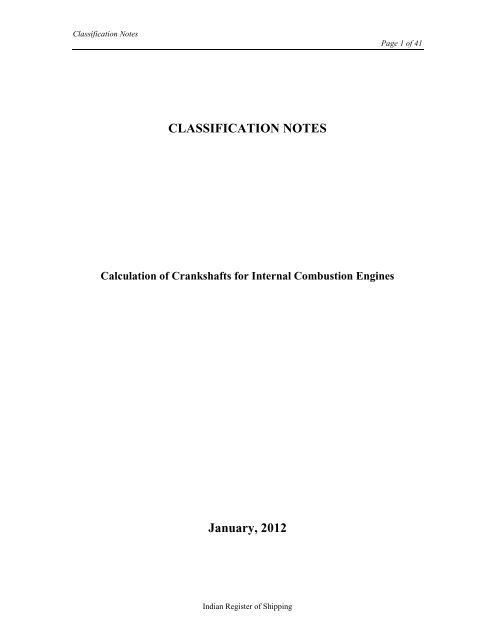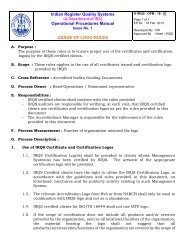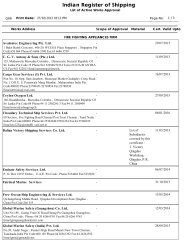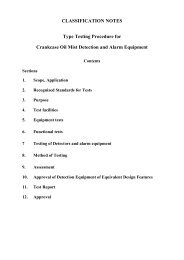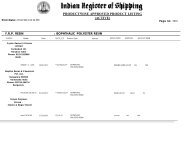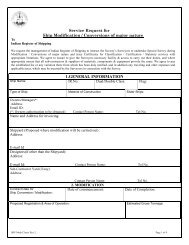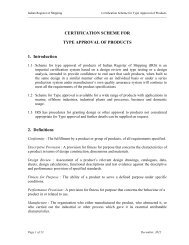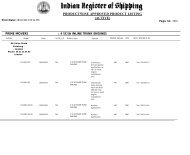CLASSIFICATION NOTES - Indian Register of Shipping
CLASSIFICATION NOTES - Indian Register of Shipping
CLASSIFICATION NOTES - Indian Register of Shipping
You also want an ePaper? Increase the reach of your titles
YUMPU automatically turns print PDFs into web optimized ePapers that Google loves.
Page 8 <strong>of</strong> 41Calculation <strong>of</strong> Crankshafts for Internal Combustion EnginesFig. 3 : Crankthrow for in line engineFig.4 : Crankthrow forVee-engine with 2 adjacentConnecting-rodsL1 = Distance between main journal centre line and crankweb centre (See also Fig.5 for crankshaftwithout overlap)L2 = Distance between main journal centre line and connecting-rod centreL3 = Distance between two adjacent main journal centre lines<strong>Indian</strong> <strong>Register</strong> <strong>of</strong> <strong>Shipping</strong>
Classification NotesPage 9 <strong>of</strong> 41Fig.5 : Reference area <strong>of</strong> crankweb cross section<strong>Indian</strong> <strong>Register</strong> <strong>of</strong> <strong>Shipping</strong>
Classification NotesPage 11 <strong>of</strong> 41X N = is considered as alternating force, moment or stressX max = is maximum value within one working cycleX min = is minimum value within one working cycle2.1.2.1 Nominal alternating bending and compressive stresses in web crosssectionThe nominal alternating bending and compressive stresses are calculated asfollows:BFN M BRFN 3Weqw.10 .KeQFN M RFNF..Kewhere, BFN [N/mm 2 ]M BRFN [Nm]nominal alternating bending stress related to the webalternating bending moment related to the center <strong>of</strong> the web(see Fig.3 and 4)MBRFN1 2MBRFmax MBRFminW eqw [mm 3 ]section modulus related to cross-section <strong>of</strong> webWeqw B.W62Keempirical factor considering to some extent the influence <strong>of</strong>adjacent crank and bearing restraint with:Ke = 0.8 for 2-stroke enginesKe = 1.0 for 4-stroke engines QFN [N/mm 2 ]nominal alternating compressive stress due to radial forcerelated to the webQ RFN [N] alternating radial force related to the web (see Fig.3 and 4)<strong>Indian</strong> <strong>Register</strong> <strong>of</strong> <strong>Shipping</strong>
Page 12 <strong>of</strong> 41Calculation <strong>of</strong> Crankshafts for Internal Combustion EnginesQRFN1 2Q QRF ma x RFminF [mm 2 ]area related to cross-section <strong>of</strong> webF = B . W2.1.2.2 Nominal alternating bending stress in outlet <strong>of</strong> crankpin oil boreThe nominal alternating bending stress is calculated as follows:MBON 3BON . 10Wewhere, BON [N/mm 2 ]M BON [Nm]nominal alternating bending stress related to the crankpindiameteralternating bending moment calculated at the outlet <strong>of</strong>crankpin oil boreMBON1 2M MBO ma x BOminwith M BO = (M BTO . cos + M BRO . sin )and [] angular position (See Fig.6)W e [mm 3 ]section modulus related to cross-section <strong>of</strong> axially boredcrankpinWe D 32 4 DD4BH2.1.3 Calculation <strong>of</strong> alternating bending stresses in filletsThe calculation <strong>of</strong> stresses is to be carried out for the crankpin fillet as well as for thejournal fillet.For the crankpin fillet:<strong>Indian</strong> <strong>Register</strong> <strong>of</strong> <strong>Shipping</strong>
Page 14 <strong>of</strong> 412.2.2 Calculation <strong>of</strong> nominal alternating torsional stressesCalculation <strong>of</strong> Crankshafts for Internal Combustion EnginesThe maximum and minimum torques are to be ascertained for every mass point <strong>of</strong> thecomplete dynamic system and for the entire speed range by means <strong>of</strong> a harmonicsynthesis <strong>of</strong> the forced vibrations from the 1 st order upto and including the 15 th order for2-stroke cycle engines and from the 0.5 th order upto and including the 12 th order for 4-stroke cycle engines. Whilst doing so, allowance must be made for the damping thatexists in the system and for unfavourable conditions (misfiring [*] in one <strong>of</strong> thecylinders). The speed step calculation shall be selected in such a way that any resonancefound in the operational speed range <strong>of</strong> the engine shall be detected.[*] Misfiring is defined as cylinder condition when no combustion occurs but onlycompression cycle.Where barred speed ranges are necessary, they shall be arranged so that satisfactoryoperation is possible despite their existence. There are to be no barred speed ranges abovea speed ratio <strong>of</strong> 0.8 for normal firing conditions.The values received from such calculation are to be submitted to IRS.The nominal alternating torsional stress in every mass point, which is essential to theassessment, results from the following equation:MTN 3N . 10WPMTN1 2MT max MT minWPπ16 D4 DDBH4orWPπ16 D4G DDGBG4where, N [N/mm 2 ]M TN [N/m]W P [mm 3 ]M Tmax [Nm]nominal alternating torsional stress referred to crankpin or journalmaximum alternating torquepolar section modulus related to cross-section <strong>of</strong> axially boredcrankpin or bored journalmaximum value <strong>of</strong> the torque<strong>Indian</strong> <strong>Register</strong> <strong>of</strong> <strong>Shipping</strong>
Classification NotesPage 15 <strong>of</strong> 41M Tmin [Nm]minimum value <strong>of</strong> the torqueFor the purpose <strong>of</strong> the crankshaft assessment, the nominal alternating torsional stressconsidered in further calculations is the highest calculated value, according to abovemethod, occurring at the most torsionally loaded mass point <strong>of</strong> the crankshaft system.Where barred speed ranges exist, the torsional stresses within these ranges are not to beconsidered for assessment calculations.The approval <strong>of</strong> crankshaft will be based on the installation having the largest nominalalternating torsional stress (but not exceeding the maximum figure specified by enginemanufacturer).Thus, for each installation, it is to be ensured by suitable calculation that this approvednominal alternating torsional stress is not exceeded. This calculation is to be submittedfor assessment.2.2.3 Calculation <strong>of</strong> alternating torsional stresses in fillets and outlet <strong>of</strong> crankpin oilboreThe calculation <strong>of</strong> stresses is to be carried out for the crankpin fillet, the journal fillet andthe outlet <strong>of</strong> the crankpin oil bore.For the crankpin fillet:τH αT. τNwhere, H [N/mm 2 ] T[-] N [N/mm 2 ]alternating torsional stress in crankpin filletstress concentration factor for torsion in crankpin fillet(determination – see clause 3.3)nominal alternating torsional stress related to crankpin diameterFor the journal fillet (not applicable to semi-built crankshafts)τG βT. τNwhere, G [N/mm 2 ]alternating torsional stress in journal fillet<strong>Indian</strong> <strong>Register</strong> <strong>of</strong> <strong>Shipping</strong>
Page 16 <strong>of</strong> 41Calculation <strong>of</strong> Crankshafts for Internal Combustion Engines T[-] N [N/mm 2 ]stress concentration factor for torsion in journal fillet(determination – see clause 3.3)nominal alternating torsional stress related to journal diameterFor the outlet <strong>of</strong> crankpin oil boreTO . τTNwhere,TO [N/mm 2 ] alternating stress in outlet <strong>of</strong> crankpin oil bore due to torsionT[-] stress concentration factor for torsion in outlet <strong>of</strong> crankpin oil bore(determination – see clause 3.3) N [N/mm 2 ]nominal alternating torsional stress related to crankpin diameter<strong>Indian</strong> <strong>Register</strong> <strong>of</strong> <strong>Shipping</strong>
Classification NotesPage 17 <strong>of</strong> 41Section 3Evaluation <strong>of</strong> stress concentration factors3.1 GeneralThe stress concentration factors are evaluated by means <strong>of</strong> the formulae according toitems 3.3.2, 3.3.3 and 3.3.4 applicable to the fillets and crankpin oil bore <strong>of</strong> solid forgedweb-type crankshafts and to the crankpin fillets <strong>of</strong> semi-built crankshafts only. It must benoticed that stress concentration factor formulae concerning the oil bore are onlyapplicable to a radially drilled oil hole. All formulae are based on investigations <strong>of</strong> FVV(Forschungsvereinigung Verbrennungskraftmaschinen) for fillets and on investigations <strong>of</strong>ESDU (Engineering science Data Unit) for oil holes. All crank dimensions necessary forthe calculation <strong>of</strong> stress concentration factors are shown in Fig.7.Where the geometry <strong>of</strong> the crankshaft is outside the boundaries <strong>of</strong> the analytical stressconcentration factors (SCF) the calculation method detailed in Appendix III may beundertaken.The stress concentration factor for bending ( B , B ) is defined as the ratio <strong>of</strong> themaximum equivalent stress (VON MISES) – occurring in the fillets under bending load –to the nominal bending stress related to the web cross-section (see Appendix I).The stress concentration factor for compression ( Q ) in the journal fillet is defined as theratio <strong>of</strong> the maximum equivalent stress (VON MISES) – occurring in the fillet due to theradial force – to the nominal compressive stress related to the web cross-section.The stress concentration factor for torsion ( T , T ) is defined as the ratio <strong>of</strong> the maximumequivalent stress – occurring in the fillets under torsional load – to the nominal torsionalstress related to the axially bored crankpin or journal cross-section (See Appendix I).The stress concentration factor for bending ( B ) and torsion ( T ) are defined as the ratio <strong>of</strong>the maximum principal stress – occurring in the outlet <strong>of</strong> the crankpin oil-hole underbending and torsional loads – to the corresponding nominal stress related to the axiallybored crankpin cross section (See Appendix II).<strong>Indian</strong> <strong>Register</strong> <strong>of</strong> <strong>Shipping</strong>
Page 18 <strong>of</strong> 41Calculation <strong>of</strong> Crankshafts for Internal Combustion EnginesFig.7 : Crank dimensionsWhen reliable measurements and/or calculations are available, which can allow directassessment <strong>of</strong> stress concentration factors, the relevant documents and their analysismethod have to be submitted to IRS in order to demonstrate their equivalence to presentrule requirements.Actual dimensions:D [mm] crankpin diameterD BH [mm] diameter <strong>of</strong> axial bore in crankpinD o [mm] diameter <strong>of</strong> oil bore in crankpinR H [mm] fillet radius <strong>of</strong> crankpinT H [mm] recess <strong>of</strong> crankpin filletD G [mm] journal diameterD BG [mm] diameter <strong>of</strong> axial bore in journalR G [mm] fillet radius <strong>of</strong> journalT G [mm] recess <strong>of</strong> journal filletE [mm] pin eccentricityS [mm] pin overlap<strong>Indian</strong> <strong>Register</strong> <strong>of</strong> <strong>Shipping</strong>
Classification NotesPage 19 <strong>of</strong> 41S D D2GEW(*) [mm]web thicknessB(*) [mm] web width(*) in the case <strong>of</strong> 2 stroke semi-built crankshafts:When T H > R H , the web thickness must be considered as equal to:Wred = W – (T H – R H ) [refer to Fig.5]Web width B must be taken in way <strong>of</strong> crankpin fillet radius centreaccording to Fig.5.The following related dimensions will be applied for the calculation <strong>of</strong> stressconcentration factors in:Crankpin fillet Journal filletr = R H / Dr = R G / Ds = S/Dw = W/D crankshafts with overlapWred/D crankshafts without overlapb = B/Dd o = D o /Dd G = D BG /Dd H = D BH /Dt H = T H /Dt G = T G /DStress concentration factors are valid for the range <strong>of</strong> related dimensions for which theinvestigations have been carried out. Ranges are as follows:s 0.50.2 w 0.81.1 b 2.20.03 r 0.130 d G 0.80 d H 0.80 d o 0.2Low range <strong>of</strong> s can be extended down to large negative values provided that:<strong>Indian</strong> <strong>Register</strong> <strong>of</strong> <strong>Shipping</strong>
Page 20 <strong>of</strong> 41Calculation <strong>of</strong> Crankshafts for Internal Combustion EnginesIf calculated f (recess) < 1 then the factor f (recess) is not to be considered(f (recess)=1)If s < -0.5 then f (s,w) and f(r,s) are to be evaluated replacing actual value<strong>of</strong> s by –0.5.3.2 Crankpin filletThe stress concentration factor for bending ( B ) is:( B = 2.6914 . f (s,w) . f(w) . f(b) . f(r) . f(d G ) . f(d H ) . f (recess)where,f (s,w) = -4.1883 + 29.2004 . w – 77.5925 . w 2 + 91.9454 . w 3 – 40.0416 .w 4 +(1-s) . (9.5440 – 58.3480 / w + 159.3415 . w 2 – 192.5846 . w 3 + 85.2916 /w 4 ) + (1-s) 2 . (-3.8399 + 25.0444 . w – 70.5571 . w 2 + 87.0328 . w 3 –39.1832 . w 4 )f (w) = 2.1790 . w 0.7171f (b) = 0.6840 – 0.0077 . b + 0.1473 . b 2f (r) = 0.2081 . r (-0.5231)f (d G ) = 0.9993 + 0.27 . d G – 1.0211 . d 2 3G + 0.5306 . d Gf (d H ) = 0.9978 + 0.3145 . d H – 1.5241 . d 2 3H + 2.4147 . d Hf (recess) = 1 + (t H + t G ) . (1.8 + 3.2 . s)The stress concentration factor for torsion ( ) is:where, = 0.8 . f (r,s) . f(b) . f(w)f (r,s) =(-0.322 + 0.1015 . 1-a))rf (b) = 7.8955 – 10.654 > b + 5.3482 . b 2 – 0.857 . b 3f (w) = w (-0.145)3.3 Journal fillet (not applicable to semi-built crankshaft)The stress concentration factor for bending ( B ) is: B = 2.7146 . f B (s,w) . f B (w) f B (w) . f B (b) . f B (r) . f B (d G ) . f B (d H ) . f (recess)where,<strong>Indian</strong> <strong>Register</strong> <strong>of</strong> <strong>Shipping</strong>
Classification NotesPage 21 <strong>of</strong> 41f B (s,w)= -1.7625 + 2.9821 . w – 1.5276 . w 2 + (1-s) . (5.1169 – 5.8089 . w + 3.1391. w 2 + (1-s) 2 . (-2.1567 + 2.3297 . w – 1.2952 . w 2 )f B (w) = 2.2422 . w 0.7548f B (b) = 0.5616 + 0.1197 . b + 0.1176 . b 2f (r) = 0.1908 . r (-0.5568)f B (d G ) =21.0012 - 0.6441 . d G + 1.2265 . d Gf B (d H ) =21.0022 - 0.1903. d H + 0.0073 . d Hf (recess) = 1 + (t H + t G ) . (1.8 + 3.2 . s)The stress concentration factor for compression ( Q ) due to the radial force is: Q = 3.0128 . f Q (s) . f Q (w) . f Q (b) . f Q (r) . f Q (d H ) . f (recess)where,f Q (s) = 0.4368 + 2.1630 . (1-s) - 1.5212 . (1-s) 2f Q (w) =f Q (b) =w0.0637 0.9369.w-0.5 + bf Q (r) = 0.5331 . r (-0.2038)f Q (d H ) =20.9937 - 1.1949 . d H + 1.7373 . d Hf (recess) = 1 + (t H + t G ) . (1.8 + 3.2 . s)The stress concentration factor for torsion ( T ) is, T = if the diameters and fillet radii <strong>of</strong> crankpin and journal are same.If crankpin and journal diameters and/or radii are <strong>of</strong> different sizes, then T = 0.8 . f (r,s) . f(b) . f(w)where,f (r,s), f(b) and f(w) are to be determined in accordance with clause 3.2 (see calculation <strong>of</strong>T), however, the radius <strong>of</strong> the journal fillet is to be related to the journal diameter:<strong>Indian</strong> <strong>Register</strong> <strong>of</strong> <strong>Shipping</strong>
Page 22 <strong>of</strong> 41Calculation <strong>of</strong> Crankshafts for Internal Combustion Enginesr RDGG3.4 Outlet <strong>of</strong> crankpin oil boreThe stress concentration factor for bending ( B ) is:2 B = 3 – 5.88 . d o + 34.6 . d oThe stress concentration factor for bending ( T ) is:2 T = 4 – 6 . d o + 30 . d o<strong>Indian</strong> <strong>Register</strong> <strong>of</strong> <strong>Shipping</strong>
Classification NotesPage 23 <strong>of</strong> 41Section 4Additional Bending Stresses4.1 In addition to the alternating bending stresses in fillets (see clause 2.1.3) furtherbending stresses due to misalignment and bedplate deformation as well as due to axialand bending vibrations are to be considered by applying add as given by table:Type <strong>of</strong> engine add [N/mm 2 ]Crosshead engines 30 (*)Trunk piston engines 10(*) The additional stress <strong>of</strong> 30 [N/mm 2 ] consists <strong>of</strong> two components1) an additional stress <strong>of</strong> 20 [N/mm 2 ] resulting from axial vibration2) an additional stress <strong>of</strong> 10 [N/mm 2 ] resulting from misalignment / bedplatedeformationIt is recommended that a value <strong>of</strong> 20 [N/mm 2 ] be used for the axial vibrationcomponent for assessment purposes where axial vibration calculation results <strong>of</strong> thecomplete dynamic system (engine/shafting/gearing/propeller) are not available. Whereaxial vibration calculation results <strong>of</strong> the complete dynamic system are available, thecalculated figures may be used instead.<strong>Indian</strong> <strong>Register</strong> <strong>of</strong> <strong>Shipping</strong>
Page 24 <strong>of</strong> 41Calculation <strong>of</strong> Crankshafts for Internal Combustion EnginesSection 5Calculation <strong>of</strong> Equivalent Alternating Stress5.1 GeneralIn the fillets, bending and torsion lead to two different biaxial stress fields which can berepresented by a Von Mises equivalent stress with the additional assumptions thatbending and torsional stresses are time phased and the corresponding peak values occurat the same location (See Appendix I). As a result the equivalent alternating stress is to becalculated for the crankpin fillet as well as for the journal fillet by using the Von Misescriterion.At the oil hole outlet, bending and torsion lead to two different stress fields which can berepresented by an equivalent principal stress equal to the maximum <strong>of</strong> principal stressresulting from combination <strong>of</strong> these two stress fields with the assumption that bendingand torsion are time phased (See Appendix II).The above two different ways <strong>of</strong> equivalent stress evaluation lead to stresses which maybe compared to the same fatigue strength value <strong>of</strong> crankshaft assessed according to VonMises criterion.5.2 Equivalent alternating stressThe equivalent alternating stress is calculated in accordance with the formulae given.For the crankpin fillet:σv 2 2σ σ 3.τBHaddHFor the journal fillet:σv 2 2σ σ 3.τBGaddGFor the outlet <strong>of</strong> crankpin oil bore:where,σv1 σ3BO. 1 29 σ14 σroBO2 v [N/mm 2 ] equivalent alternating stressfor other parameters see items 2.1.3, 2.2.3 and 3.4.<strong>Indian</strong> <strong>Register</strong> <strong>of</strong> <strong>Shipping</strong>
Classification NotesPage 25 <strong>of</strong> 41Section 6Calculation <strong>of</strong> Fatigue StrengthThe fatigue strength is to be understood as that value <strong>of</strong> equivalent alternating stress (VonMises) which a crankshaft can permanently withstand at the most highly stressed points.The fatigue strength may be evaluated by means <strong>of</strong> the following formulae:Related to the crankpin diameter:σDW K.0.2785 B 196 10.42.σ 39.3.0.264 1.073.D . B4900σBRxwith:R x = R Hin the fillet areaR x = D o / 2 in the oil bore areaRelated to the journal diameter:σDW K.0.2785 B 196 10.42.σ 39.3.0.264 1.073.DG . B4900σBRGwhere, DW [N/mm 2 ]K [-]allowable fatigue strength <strong>of</strong> crankshaftfactor for different types <strong>of</strong> crankshafts without surface treatment.Values greater than 1 are only applicable to fatigue strength infillet area.= 1.05 for continuous grain flow forged or drop-forged crankshafts= 1.0 for free from forged crankshafts (without continuous grainflow)factor for cast steel crankshafts with cold rolling treatment in filletarea= 0.93 for cast steel crankshafts manufactured by companies usingan approved cold rolling process B [N/mm 2 ]minimum tensile strength <strong>of</strong> crankshaft material<strong>Indian</strong> <strong>Register</strong> <strong>of</strong> <strong>Shipping</strong>
Page 26 <strong>of</strong> 41Calculation <strong>of</strong> Crankshafts for Internal Combustion EnginesFor other parameters see clause 3.3.When a surface treatment process is applied, it must be approved by IRS.These formulae are subject to the following conditions:Surfaces <strong>of</strong> the fillet, the outlet <strong>of</strong> the oil bore and inside the oil bore (down to aminimum depth equal to 1.5 times the oil bore diameter) shall be smoothlyfinished.For calculation purposes R H , R G or R x are to be taken as not less than 2 [mm].As an alternative the fatigue strength <strong>of</strong> the crankshaft can be determined by experimentbased either on full size crankthrow (or crankshaft) or on specimens taken from a full sizecrankthrow.In any case the experimental procedure for fatigue evaluation <strong>of</strong> specimens and fatiguestrength <strong>of</strong> crankshaft assessment have to be submitted for approval to IRS (method, type<strong>of</strong> specimens, number <strong>of</strong> specimens (or crankthrows), number <strong>of</strong> tests, survivalprobability, confidence number etc.).<strong>Indian</strong> <strong>Register</strong> <strong>of</strong> <strong>Shipping</strong>
Classification NotesPage 27 <strong>of</strong> 41Section 7Acceptability CriteriaThe adequate dimensioning <strong>of</strong> a crankshaft is confirmed by a comparison <strong>of</strong> theequivalent alternating stress and the fatigue strength. This comparison has to be carriedout for the crankpin fillet, the journal fillet, the outlet <strong>of</strong> crankpin oil bore and is based onthe formula:where,Q [-]σQ σDWvacceptability factor.Adequate dimensioning <strong>of</strong> the crankshaft is ensured if the smallest <strong>of</strong> all acceptabilityfactors satisfies the criteria:Q 1.15<strong>Indian</strong> <strong>Register</strong> <strong>of</strong> <strong>Shipping</strong>
Page 28 <strong>of</strong> 41Calculation <strong>of</strong> Crankshafts for Internal Combustion EnginesSection 8Calculation <strong>of</strong> Shrink-fits <strong>of</strong> Semi-built Crankshaft8.1 GeneralAll crank dimensions necessary for the calculation <strong>of</strong> the shrink-fit are shown in Fig.8.where,Fig.8 : Crankthrow <strong>of</strong> semi-built crankshaftD A [mm] outside diameter <strong>of</strong> web or twice the minimum distance x betweencentre-line <strong>of</strong> journals and outer contour <strong>of</strong> web, whichever is lessD s [mm] shrink diameterD G [mm] journal diameterD BG [mm] diameter <strong>of</strong> axial bore in journalL s [mm] length <strong>of</strong> shrink-fitR G [mm] fillet radius <strong>of</strong> journal<strong>Indian</strong> <strong>Register</strong> <strong>of</strong> <strong>Shipping</strong>
Classification NotesPage 29 <strong>of</strong> 41y [mm] distance between the adjacent generating lines <strong>of</strong> journal and piny 0.05 . D swhere y is less than 0.1 . D s special consideration is to be given tothe effect <strong>of</strong> the stress due to the shrink-fit on the fatigue strengthat the crankpin fillet.Regarding the radius <strong>of</strong> the transition from the journal to the shrink diameter, thefollowing should be complied with:andR G 0.015 * D GR G 0.5 * (D s – D G )where the greater value is to be considered.The actual oversize Z <strong>of</strong> the shrink-fit must be within the limits Z min and Z max calculatedin accordance with clause 8.3 and 8.4.In the case where 8.2 condition cannot be fulfilled then 8.3 and 8.4 calculation methods<strong>of</strong> Z min and Z max are not applicable due to multizone-plasticity problems.In such case Z min and Z max have to be established based on FEM calculations.8.2 Maximum permissible hole in the journal pinThe maximum permissible hole diameter in the journal pin is calculated in accordancewith the following formula:DBG D s4000S1μ π DR2sMLsmax σSPwhere,S R [-] safety factor against slipping, however a value not less than 2 is tobe taken unless documented by experiments.M max [Nm]absolute maximum value <strong>of</strong> the torque M Tmax in accordance with2.2.2.<strong>Indian</strong> <strong>Register</strong> <strong>of</strong> <strong>Shipping</strong>
Page 30 <strong>of</strong> 41Calculation <strong>of</strong> Crankshafts for Internal Combustion Engines [-] coefficient for static friction, however, a value not greater than 0.2is to be taken unless documented by experiments. SP [N/mm 2 ] minimum yield strength <strong>of</strong> material for journal pinThis condition serves to avoid plasticity in the hole <strong>of</strong> the journal pin.8.3 Necessary minimum oversize <strong>of</strong> shrink-fitThe necessary minimum oversize is calculated according to, and considering greater <strong>of</strong>the two values:ZminσswE DmsandZmin4000 S μ π EmR M DSmax LS1QA S221 Q 1 Q A2 Q2Swhere,Z min [mm] minimum oversizeE m [N/mm 2 ] Young’s modulus SW [N/mm 2 ] minimum yield strength <strong>of</strong> material for crank webQ A [-] web ratio,Q S [-] shaft ratio,Q AQ SDDDSADBGS8.4 Maximum permissible oversize <strong>of</strong> shrink-fitThe maximum permissible oversize is calculated according to:Zmax DS σ ESWm0.8 1000 This condition serves to restrict the shrinkage induced mean stress in the fillet.<strong>Indian</strong> <strong>Register</strong> <strong>of</strong> <strong>Shipping</strong>
Classification NotesPage 31 <strong>of</strong> 41Appendix I : Definition <strong>of</strong> stress concentration factors in crankshaft fillets<strong>Indian</strong> <strong>Register</strong> <strong>of</strong> <strong>Shipping</strong>
Page 32 <strong>of</strong> 41Calculation <strong>of</strong> Crankshafts for Internal Combustion EnginesAppendix II : Stress concentration factors and stress distribution at theedge <strong>of</strong> oil drillings<strong>Indian</strong> <strong>Register</strong> <strong>of</strong> <strong>Shipping</strong>
Classification NotesPage 33 <strong>of</strong> 41Appendix IIIAlternative method for Calculation <strong>of</strong> Stress Concentration Factors in the web filletradii <strong>of</strong> crankshafts by utilizing Finite Element MethodSection 1GeneralThe objective <strong>of</strong> the analysis is to develop Finite Element Method (FEM) calculatedfigures as an alternative to the analytically calculated Stress Concentration Factors (SCF)at the crankshaft fillets. The analytical method is based on empirical formulae developedfrom strain gauge measurements <strong>of</strong> various crank geometries and accordingly theapplication <strong>of</strong> these formulae is limited to those geometries.The SCFs calculated according to the rules <strong>of</strong> this document are defined as the ratio <strong>of</strong>stresses calculated by FEM to nominal stresses in both journal and pin fillets. When usedin connection with the method in General method given in Section 1 to 8 and Appendix Iand II or the alternative method, von Mises stresses are to be calculated for bending andprincipal stresses for torsion. .The procedure as well as evaluation guidelines are valid for both solid cranks andsemibuilt cranks (except journal fillets).The analysis is to be conducted as linear elastic FE analysis, and unit loads <strong>of</strong> appropriatemagnitude are to be applied for all load cases.The calculation <strong>of</strong> SCF at the oil bores is not covered by this document.It is advised to check the element accuracy <strong>of</strong> the FE solver in use, e.g. by modeling asimple geometry and comparing the stresses obtained by FEM with the analyticalsolution for pure bending and torsion.Boundary Element Method (BEM) may be used instead <strong>of</strong> FEM.<strong>Indian</strong> <strong>Register</strong> <strong>of</strong> <strong>Shipping</strong>
Classification NotesPage 35 <strong>of</strong> 41parameters have to be used, either as quoted in literature or as measured on representativematerial samples.In the absence <strong>of</strong> above information the following values are to be used for steel: E=52.05· 10 MPa and =0.3.2.3 Element mesh quality criteriaFig.2.1 : Oil bore proximity to filletIf the actual element mesh does not fulfill any <strong>of</strong> the following criteria at the examinedarea for SCF evaluation, then a second calculation with a refined mesh is to beperformed.2.3.1 Principal stresses criterionThe quality <strong>of</strong> the mesh should be assured by checking the stress component normalto the surface <strong>of</strong> the fillet radius. Ideally, this stress should be zero. With principalstresses 1, 2and 3the following criterion is required:min , , 0.03.max , 1 2 31 2,2.3.2 Averaged/unaveraged stresses criterionThe criterion is based on observing the discontinuity <strong>of</strong> stress results over elements at thefillet for the calculation <strong>of</strong> SCF:o The difference between the unaveraged nodal stress results calculated from eachelement connected to a nodeiand the 100 % averaged nodal stress results at thisnode at the examined location is not to be more than 5 %.i3<strong>Indian</strong> <strong>Register</strong> <strong>of</strong> <strong>Shipping</strong>
Page 36 <strong>of</strong> 41Calculation <strong>of</strong> Crankshafts for Internal Combustion EnginesAppendix III - Section 3Load CasesTo substitute the analytically determined SCF in General method given in Section 1 to 8and Appendix I and II the following load cases have to be calculated.3.1 TorsionIn analogy to the testing apparatus used for the investigations made by FVV( refer sect3.1 <strong>of</strong> General method) the structure is loaded in pure torsion. In the model surface warpat the end faces is suppressed.Torque is applied to the central node located at the crankshaft axis. This node acts as themaster node with 6 degrees <strong>of</strong> freedom and is connected rigidly to all nodes <strong>of</strong> the endface.Boundary and load conditions are valid for both in-line and V-type engines.Fig. 3.1 : Boundary and load conditions for the torsion load caseFor all nodes in both the journal and crank pin fillet principal stresses are extracted andthe equivalent torsional stress is calculated:<strong>Indian</strong> <strong>Register</strong> <strong>of</strong> <strong>Shipping</strong>
Classification NotesPage 37 <strong>of</strong> 41 122313 equiv max , , 2 2 2 The maximum value taken for the subsequent calculation <strong>of</strong> the SCF:TNequivTequiv,N,where Nis nominal torsional stress referred to the crankpin and respectively journal asper General method given in Section 1 to 8 and Appendix I and II , 2.2.2 with thetorsional torque T:NTWP3.2 Pure bending (4 point bending)In analogy to the testing apparatus used for the investigations made by FVV the structureis loaded in pure bending. In the model, surface warp at the end faces is suppressed.The bending moment is applied to the central node located at the crankshaft axis. Thisnode acts as the master node with 6 degrees <strong>of</strong> freedom and is connected rigidly to allnodes <strong>of</strong> the end face.Boundary and load conditions are valid for both in-line- and V- type engines.For all nodes in both the journal and pin fillet von Mises equivalent stresses equivareextracted. The maximum value is used to calculate the SCF according to:BBNequiv,equiv,NNominal stress Nis calculated as per General method given in Section 1 to 8 andAppendix I and II , 2.1.2.1 with the bending moment M:NMWeqw<strong>Indian</strong> <strong>Register</strong> <strong>of</strong> <strong>Shipping</strong>
Page 38 <strong>of</strong> 41Calculation <strong>of</strong> Crankshafts for Internal Combustion EnginesFig. 3.2 : Boundary and load conditions for the pure bending load case3.3 Bending with shear force (3-point bending)This load case is calculated to determine the SCF for pure transverse force (radial force, ) for the journal fillet.QIn analogy to the testing apparatus used for the investigations made by FVV, the structureis loaded in 3-point bending. In the model, surface warp at both the end faces issuppressed. All nodes are connected rigidly to the centre node; boundary conditions areapplied to the centre nodes. These nodes act as master nodes with 6 degrees <strong>of</strong> freedom.The force is applied to the central node located at the pin centre-line <strong>of</strong> the connectingrod. This node is connected to all nodes <strong>of</strong> the pin cross sectional area. Warping <strong>of</strong> thesectional area is not suppressed.Boundary and load conditions are valid for in-line and V-type engines. V-type enginescan be modeled with one connecting rod force only. Using two connecting rod forces willmake no significant change in the SCF.<strong>Indian</strong> <strong>Register</strong> <strong>of</strong> <strong>Shipping</strong>
Page 40 <strong>of</strong> 41Calculation <strong>of</strong> Crankshafts for Internal Combustion EnginesFig. 3.4 : Load applications for in-line and V-type enginesThe maximum equivalent von Mises stress 3Pin the journal fillet is evaluated. The SCFin the journal fillet can be determined in two ways as shown below.3.3.1 Method 1This method is analogous to the FVV investigation. The results from 3-point and 4-pointbending are combined as follows: . 3P N3P. BQ3PQwhere:3Pas found by the FE calculation.N 3PNominal bending stress in the web centre due to the force F 3 P[N] applied to thecentre-line <strong>of</strong> the actual connecting rod, see figure 3.4.Bas determined in paragraph 3.2.Q3P= Q3 P/( B.W)where Q 3 Pis the radial (shear) force in the web due to the force F 3 P[N] applied to the centre-line <strong>of</strong> the actual connecting rod, see also figures 3 and 4 inGeneral method given in Section 1 to 8 and Appendix I and II .3.3.2 Method 2This method is not analogous to the FVV investigation. In a statically determined systemwith one crank throw supported by two bearings, the bending moment and radial (shear)force are proportional. Therefore the journal fillet SCF can be found directly by the 3-point bending FE calculation.<strong>Indian</strong> <strong>Register</strong> <strong>of</strong> <strong>Shipping</strong>
Classification NotesPage 41 <strong>of</strong> 41The SCF is then calculated according to BQ3PN 3PFor symbols see 3.3.1.When using this method the radial force and stress determination in General methodgiven in Section 1 to 8 and Appendix I and II becomes superfluous. The alternatingbending stress in the journal fillet as per General method given in Section 1 to 8 andAppendix I and II , 2.1.3 is then evaluated: . BGBQBFNNote that the use <strong>of</strong> this method does not apply to the crankpin fillet and that this SCFmust not be used in connection with calculation methods other than those assuming astatically determined system as in General method given in Section 1 to 8 and Appendix Iand II .<strong>Indian</strong> <strong>Register</strong> <strong>of</strong> <strong>Shipping</strong>


